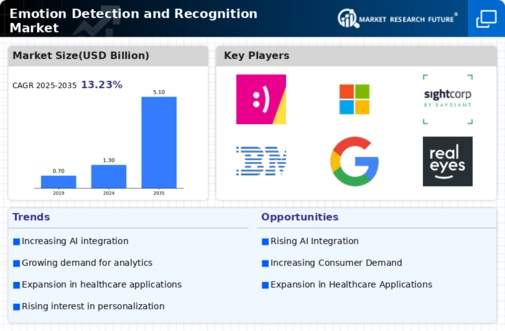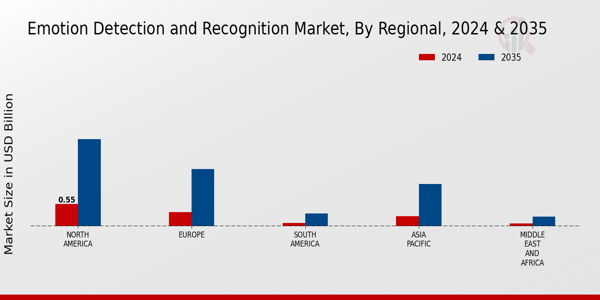Market Growth Projections
Regulatory Support and Funding Initiatives
Regulatory support and funding initiatives play a crucial role in the development of the Global Emotion Detection and Recognition Market Industry. Governments are increasingly investing in research and development to promote technologies that enhance emotional intelligence and mental health. For instance, funding programs aimed at fostering innovation in emotion detection technologies are being established, which may lead to breakthroughs in the field. This supportive environment is likely to stimulate market growth, as more companies enter the space and develop novel solutions.
Growing Focus on Mental Health and Wellbeing
There is a heightened focus on mental health and wellbeing, significantly influencing the Global Emotion Detection and Recognition Market Industry. Organizations and institutions are increasingly recognizing the importance of emotional health, leading to the adoption of emotion detection technologies in therapeutic settings. These tools assist mental health professionals in assessing patients' emotional states, thereby improving treatment efficacy. As awareness of mental health issues continues to rise, the demand for such technologies is expected to grow, further propelling the market forward.
Rising Demand for Emotion-Aware Technologies
The Global Emotion Detection and Recognition Market Industry experiences a surge in demand for technologies that can interpret human emotions. This trend is driven by the increasing integration of emotion recognition systems in various sectors, including healthcare, automotive, and entertainment. For instance, healthcare providers utilize these technologies to enhance patient care by monitoring emotional states, which can lead to better treatment outcomes. The market is projected to reach 1.3 USD Billion in 2024, reflecting a growing recognition of the importance of emotional intelligence in technology.
Increasing Applications in Consumer Electronics
The Global Emotion Detection and Recognition Market Industry is witnessing an expansion in applications within consumer electronics. Devices such as smartphones and smart home systems are increasingly incorporating emotion recognition capabilities to personalize user experiences. For example, smartphones can adjust settings based on the user's emotional state, enhancing user satisfaction. This trend is likely to contribute to the market's growth, as consumers increasingly seek devices that understand and respond to their emotional needs. The projected CAGR of 13.23% from 2025 to 2035 underscores the potential for innovation in this sector.
Advancements in Artificial Intelligence and Machine Learning
Technological advancements in artificial intelligence and machine learning are pivotal to the growth of the Global Emotion Detection and Recognition Market Industry. These innovations enable more accurate emotion recognition through sophisticated algorithms that analyze facial expressions, voice tones, and physiological signals. Companies are increasingly adopting AI-driven solutions to enhance user experiences, particularly in customer service and marketing. The anticipated growth from 1.3 USD Billion in 2024 to 5.1 USD Billion by 2035 indicates a robust market trajectory, driven by these technological enhancements.



















